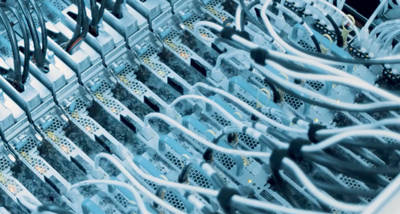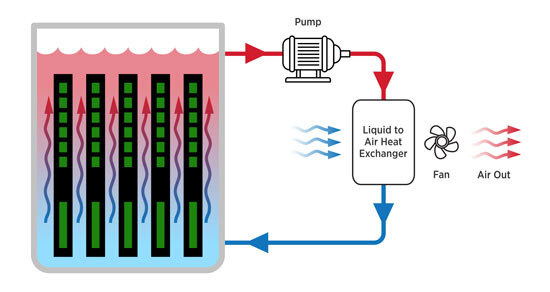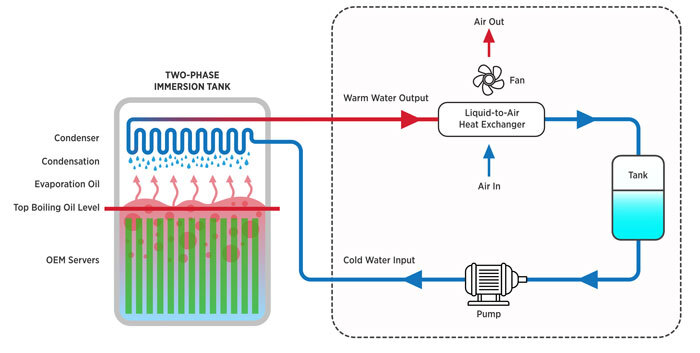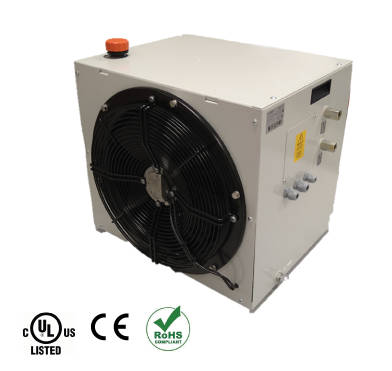Introduction
Increased server rack density has been greatly impacted by advancements in artificial intelligence, Internet of Things (IoT), machine learning, blockchain, cryptocurrency and the demand for increased computing power and performance requirements. This has contributed to an increase in the amount of heat generated in data centers. Traditional methods of air cooling have fallen short of meeting the thermal management requirements for the latest generation of servers, central processing units (CPUs) and graphics processing units (GPUs).

Traditional air cooling methods are inefficient and expensive to dissipate the large amount of heat generated in data centers.
Immersion cooling has become an ever-increasingly popular method when it comes to heat dissipation and cooling of high-performance computing and cloud computing. Immersion cooling submerges the hardware into a heat-conducting dielectric liquid that recycles drawn-out heat into cooler liquid. With the use of heat exchangers or chilled condensers, immersion cooling brings an ideal method of bulk heat removal and temperature control to data servers.
Product designs are continually packaging more components into more compact enclosures. This has greatly impacted the performance and designs of today’s servers, CPUs, and GPUs. Dense server farms of large data files that support high-trafficked websites, video and sound files paired with the faster performance capability of today’s CPUs, GPUs, and servers, are generating larger amounts of heat that need to be dissipated. In addition, the more power flowing through the processors means hotter chips, which translates into the need for improved cooling, or the chips will malfunction.
The cost of traditional air-cooling systems is extremely high and inefficient. Air cooling includes the use of fans to direct air towards a heat source and exhaust the warmer air. The required energy to air condition and power the fans compounds the problem of controlling operating costs for data center managers and operators. This is why alternative cooling methods like immersion cooling have been developed to lower operating costs and improve energy efficiency, while still preventing system failures and shutdowns caused by overheating.

Due to the improved energy efficiency and lower operating costs, immersion cooling has become popular for cooling high-performance computing equipment.
Immersion Cooling
The immersion cooling market is projected to grow from $243m to $700m by 2026 (ResearchAndMarkets.com). When compared to traditional air cooling methods, liquid immersion cooling proves to be the more efficient cooling method. Immersion cooling removes the need for additional cooling fans, expanding the processing abilities confined in smaller sizes and space. Immersion cooling has demonstrated a performance increase of up to 20% for some chipsets. With immersion cooling, the heat is transferred directly from the heat source to the working fluid.
The working fluid must be non-conductive which limits it to four families of fluids:
- Deionized water
- Mineral oil
- Fluorocarbon-based fluids
- Synthetic
Immersion cooling for electronics works in one of two ways:
- Single-phase immersion cooling pumps the cooling liquid through a heat exchanger that expels heat from the system while simultaneously introducing cooled, ambient air to the immersion liquid circuit.

- Two-phase immersion involves combining the dielectric liquid with the heat generated from the submerged hardware to initiate boiling that transforms the liquid into a gas. The gas rises towards a cold-water condenser where it condenses and falls back into the immersion pool.

Through single-phase and two-phase immersion cooling, electronic equipment temperature can be thoroughly reduced and controlled in a more efficient process. Both methods exhibit significantly higher efficiency levels when compared to traditional air-cooled systems.
Datacenters employ a Power Usage Effectiveness (PUE) calculation to understand operating efficiency and whether there are opportunities for improvement. The PUE is a ratio of the total energy entering a datacenter to the energy being used of IT computing. Average datacenter PUE is around 1.8 (https://www.nrel.gov/computational-science/measuring-efficiency-pue.html). Whether single or two- phase, immersion cooling greatly improves this ratio.
Current research suggests that two-phase cooling may have a slight advantage over single-phase cooling by claiming a Power Usage Effectiveness (PUE) of 1.02 as opposed to 1.03. (https://submer.com/blog/single-phase-vs-two-phase-immersion-cooling/)
Two-phase immersion cooling requires no fans installed locally near the servers and has much faster heat dissipation due to the phase change of the immersion fluid. This achieves a higher heat density along with a lower power usage effectiveness rating. Tank-based two-phase immersion cooling utilizes boiling liquid that transitions at a constant temperature. It is easy to maintain by removing the boards from the tank and allowing the liquid to drain. Normal IT operations can create a degree of vibration and noise, which may affect the processors and hard drives and decrease the system’s lifespan. In two-phase immersion cooling, the system is immersed in the liquid that greatly alleviates the impact of vibration and noise.
Heat Exchangers and Custom Solutions for Immersion Cooling
As mentioned above, liquid cooling systems are able to dissipate a large amount of heat generated by data servers. A liquid heat exchanger system cools the coolant in a liquid circuit by the use of a liquid-to-air heat exchanger. The system circulates coolant from the heat source to the liquid cooling system. The tank creates thermal mass that helps suppress changes in heat input and ensures constant fluid to the suction of the pump.
Immersion cooling applications can use liquid heat exchangers to cool the condenser using their smaller form factor and a cooling capacity of single kilowatts up to tens of kilowatts.
Ideal for immersion cooling applications, Laird Thermal Systems’ LA5000 is a 5000 Watt liquid-to-air water heat exchanger designed to operate slightly above ambient temperatures. The closed system prevents air from entering the liquid which could cause damage to the pump. The robust design provides full-time operation, continually monitoring system liquid levels and alerts users of the need for preventative maintenance to avoid costly failure.

The LA5000 Liquid-to-Air Water Heat Exchanger offers efficient, low power operation to ensure high performance and maximum system uptime.
Custom cooling solutions are capable of dissipating from 5 kW up to 100 kW of heat. They also provide a high coefficient of performance (COP) that delivers efficient, low power operation to maximize uptime and optimize system performance. Liquid cooling systems also utilize high thermal conductivity and capacity coolants to remove bulk heat in kilowatts and cool processes down rapidly. This efficiency optimizes heat transfer delivery away from thermally sensitive components to the ambient environment.
Conclusion
Due to the increased amount of heat being generated in data centers and high-performance computing applications, traditional methods of air cooling are not meeting the thermal management requirements for today’s servers, CPUs, and GPUs.
Immersion cooling is the preferred method when it comes to heat dissipation and cooling of high-performance computing and cloud computing. Immersion cooling submerges the hardware into a heat-conducting dielectric liquid that recycles drawn out heat into cooler liquid. Utilizing heat exchangers, immersion cooling is an ideal method of bulk heat removal and temperature control for computer servers.
The LA5000 is a compact heat exchanger system providing the high heat pumping capacity and reliability needed for immersion cooling applications.
Find the LA5000 Datasheet.

